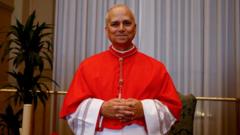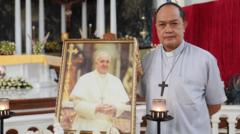As the conclave enters its second day, cardinals are deliberating the choice of the next pope amidst a growing crowd of spectators. The first vote resulted in black smoke, indicating an inconclusive outcome, which heightens the anticipation in Vatican City as the election process involves multiple rounds until a two-thirds majority is achieved.
Anticipation Grows in Vatican City as Papal Conclave Begins Voting

Anticipation Grows in Vatican City as Papal Conclave Begins Voting
An expectant crowd gathers outside St. Peter's Square, awaiting news of the ongoing conclave to elect a new pope, indicated by the black smoke signal from the Sistine Chapel.
The lines to enter St. Peter’s Square have grown longer on Thursday as crowds eagerly await updates on the proceedings of the conclave, where 133 cardinals are deliberating in the Sistine Chapel for the election of a new pope. Just before noon, black smoke emerged from the chapel’s chimney, signifying that the morning vote had yielded no consensus.
The ongoing conclave, now in its second day, brought back memories of Pope Francis's own election, which was finalized during the same time frame twelve years ago. Expectations have hence soared around a possible decision by evening, as crowds huddled under the sun or in search of shade, waiting for an announcement.
The complexities surrounding this election arise partly from the legacy of Pope Francis, whose recent passing has left the Church at a crossroads, divided between progressive ideals advocating more inclusion, and conservative factions keen on preserving traditional values. This election is unprecedented in gathering such a diverse assembly of cardinals, many of whom were appointed by Francis himself.
Voting procedures require a two-thirds majority for a candidate to be elected, with each day comprising four rounds of voting scheduled until a pope is chosen. Historically, the conclave can be lengthy or swift; while many recent elections concluded in under two days, there has been precedence for protracted deliberations lasting several years in earlier centuries.
Significantly, this conclave is noteworthy for its strict adherence to secrecy. The cardinal electors vote behind closed doors, devoid of any communication with the outside world. This gives an impression of an insulated atmosphere, where cardinals are sequestered to ensure the purity and confidentiality of their decision-making process.
The tension of the balloting process plays a vital role—it functions not just as a vote for leadership, but as a referendum on the future direction of the Catholic Church in addressing contemporary societal issues. Observers speculate that ultimately the emphasis will lie in determining how the Church will adapt to the changing global landscape, especially concerning issues such as gender equality in priesthood or LGBTQ rights.
Accompanying this sentiment of hope are reports of a considerable public interest in the papal election process, further stimulated by the recent release of popular media depicting the conclave, prompting audiences to consider the complexities within. For those gathered in St. Peter’s Square, waiting in anticipation serves as a moment of reflection on the values and direction they seek in the next leader of their faith.






















